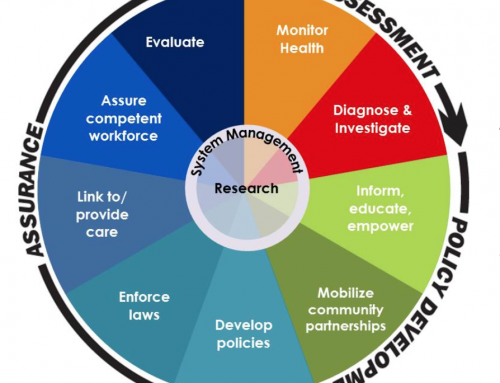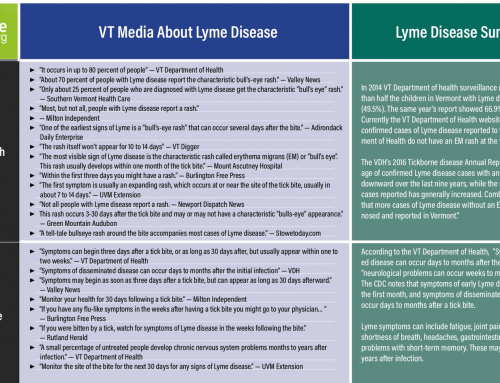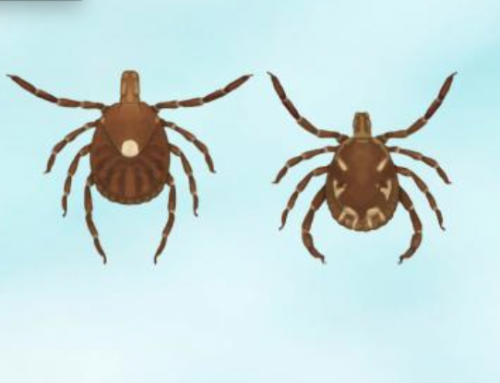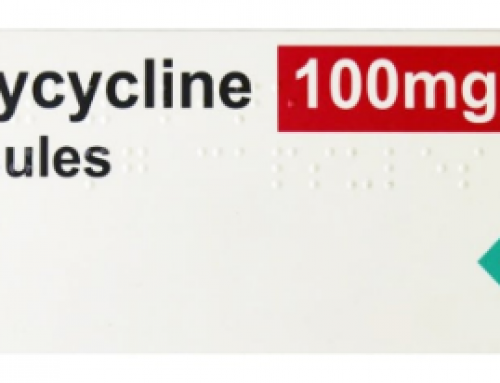- Not everyone gets a rash
According to the National Institutes of Health, “The most distinct symptom of Lyme disease—the circular red rash known as erythema migrans (EM)—does not appear in at least one quarter of people who are actually infected with Lyme bacteria.” In Vermont, recent data shows the incidence of EM rashes has been falling in Vermonters diagnosed with Lyme disease. - It’s not just Lyme disease
According to the VT Department of Health, Anaplasmosis, Babesiosis, Ehrlichiosis, Borrelia miyamotoi and Powassan Virus are all present in Vermont. Some of these tick-borne diseases may require a different treatment than Lyme disease. - In Vermont, Lyme disease is diagnosed 12 months of the year
VT Department of Health data shows confirmed cases of Lyme disease are diagnosed all 12 months in Vermont. The most cases are diagnosed May – September.

- Blood tests might not work
Because it may take weeks for antibodies to develop, according to the CDC, “testing an infected person too early can produce a negative result”. False positive tests can also occur.The VT Department of Health notes,“Even the best available Lyme testing is imperfect and should be interpreted in the context of the patient’s clinical presentation.” - A person may have symptoms weeks, months, or years after being bitten
Treatment failure does occur. Vermonters with disseminated Lyme disease may need a different treatment than those in an early stage of the disease with an early diagnosis. Other tick-borne infections, such as Babesia, may require a different approach than Lyme disease. - Not all ticks carry Lyme disease
Only four of thirteen tick species in Vermont are known to carry pathogens. One of these four is responsible for 99% of all tick-borne diseases reported in Vermont – the blacklegged tick.The VT Department of Agriculture 2018 tick report showed over 60% of the ticks tested positive for at least one disease. 56.7% were positive for Borrelia burgdorferi, which causes Lyme disease. 8.25% were positive forAnaplasma phagocytophilum (Anaplasmosis), 1.03% for Babesia microti (Babesiosis), 1.03% for Borrelia miyamotoi, and 1% for Powassan Virus. Approximately 5% of the ticks tested positive for two or more pathogens.Remember, just because you have been bitten doesn’t mean you have a tick-borne disease, and correctly identifying the type of tick that bit you will help you understand your risk of infection. - Vermont has a lot of Lyme disease
Vermont regularly tops US states for incidence of Lyme disease. The most recent CDC surveillance numbers show Vermont’s incidence per 1000,000 people is 103.6.For comparison, the incidence rate in Connecticut was 38.5, New York’s was 17.6, and Massachusetts rate was 4.7. In 2017, Maine was the only state with a higher incidence than VT, at 106.6.The CDC designates a state a “High Incidence State” when there is an average incidence of at least 10 confirmed cases per 100,000 persons for previous three reporting years. Vermont’s 3 year incidence rate is 86.7 per 100,000 persons. - Lyme can affect mood, cognitive performance, and mental health
According to the Global Mental Health Program at Columbia University “significant cognitive and psychological symptoms are being recognized as part of the symptom pattern associated with untreated and/or chronic Lyme Disease”.Depression can be a component of Lyme disease. Case studies show symptoms of Lyme disease can be similar to symptoms of schizophrenia or bi-polar disorder. Research has also shown a possible connection between Lyme disease and suicidality.In children, Lyme disease may appear as a learning disability, difficulty with processing, self-harming behavior, or ADHD. Learn more about Lyme and mental health at VTLyme.org.





